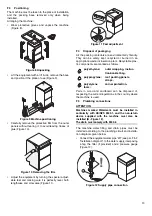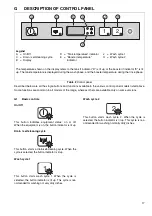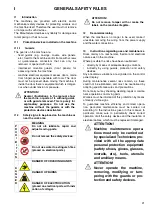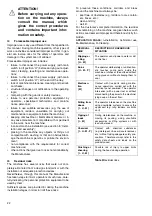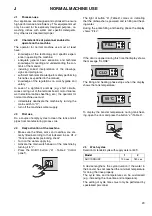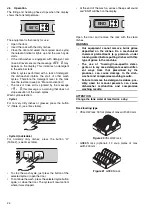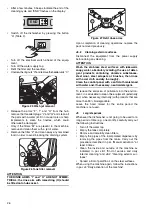
27
J10
Maintenance
The inspection and maintenance intervals depend on
the actual machine operating conditions (total wash
hours) and ambient conditions (presence of dust,
damp, etc.), therefore precise time intervals cannot be
given. In any case, careful and periodical machine
maintenance is advisable in order to minimize service
interruptions.
Therefore, it is advisable to:
•
Descale the booster, inner surfaces of the tank and
the machine's pipes once or twice a year (call the
After-Sales Service).
•
Every month descale the prewash, wash and rinse
jets with vinegar or scale remover.
•
The internal tube of the peristaltic rinse aid and
detergent dispenser must undergo periodical main-
tenance (once or twice a year).
It is also advisable to sign a preventive and sched-
uled maintenance contract with the After-Sales
Service.
J10.1 Preventive maintenance
The preventive maintenance call can be activated (call
the After-Sales Service).
When the set number of cycles (e.g. 20000) has been
reached, a call After-Sales Service message appears
on the display.
This message suggests calling a specialized techni-
cian, for a general check of the equipment.
J11
Machine disposal
At the end of the product's life-cycle, make sure it is not
dispersed in the environment. The equipment must be
disposed of in compliance with the regulations in force
in the country of use.
All metal parts are in stainless steel (AISI 304) and
removable. Plastic parts are marked with the letters of
the material.
The symbol
on the product indicates that it should
not be treated as domestic waste, but must be cor-
rectly disposed of in order to prevent any negative con-
sequences for the environment and human health.
For further information on the recycling of this product,
contact the local dealer or agent, the after-sales assis-
tance service or the local body responsible for waste
disposal.
J12
Troubleshooting
THE DISHWASHER DOES NOT SWITCH ON
1. Make sure the socket is powered.
2. Make sure the plug is properly inserted in the power
socket.
3. Check the fuse. If necessary replace it.
THE DISHWASHER DOES NOT WASH PROPERLY
1. Check the suction filter and carefully clean it if dirty.
2. Make sure the wash jets are not clogged by solid
residuals.
3. Make sure the initial quantity of detergent and/or sub-
sequent additions are correct.
4. The wash cycle used is too short. Repeat the cycle.
5. Make sure the tank temperature is at least 55°C /
131°F.
6. Make sure the dishes are correctly placed in the
racks.
GLASSES AND DISHES ARE NOT PROPERLY DRIED
1. Make sure there is rinse aid in the container and top-
up if necessary.
2. Check the amount of rinse aid used (see par. H4 “Dis-
3. Make sure the rinse water temperature is between
80°C and 90°C.
CONDENSATE ON GLASSES
1. Make sure there is rinse aid in the container and top-
up if necessary.
2. Check the amount of rinse aid used (see par. H4 “Dis-
3. Remove the rack of the glasses immediately after the end
of the cycle.
STAINS ON GLASSES
1. Only use "non-foaming" products for professional
dishwashers.
EXCESSIVE FOAM IN THE TANK
1. Make sure the wash water temperature is not below
55°C / 131°F.
2. Check if the detergent dispenser delivers an excessive
dose of product (see par. H4 “Dispenser adjustment”).
3. Make sure the tank has been cleaned with suitable
detergents. Empty the tank and rinse thoroughly
before doing other wash cycles.
4. If a foaming detergent was used, empty and refill the
tank with water until the foam has disappeared.
GLASSES WITH STREAKS OR SPOTS
1. Reduce the amount of rinse aid (see par. H4 “Dis-
THE WASH AND/OR RINSE ARMS TURN SLOWLY
1. Remove the arms and clean them thoroughly.
2. Clean the wash pump suction filter.

